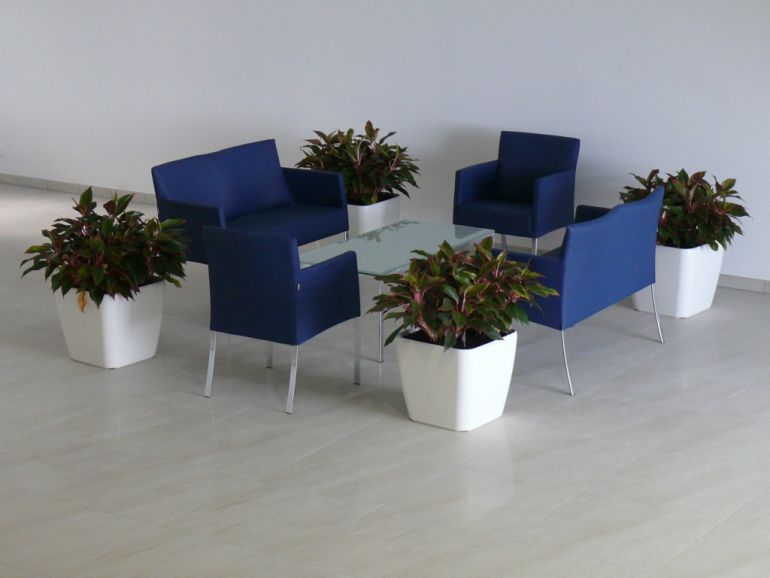Why have plants?
Benzene, xylene, trichloroethylene and methylene chloride. Sounds strange? These are only a few of chemical compounds, present in the office room air. Their appearance and combinations may negatively affect the employees' health. Volatile organic compounds may not only cause allergies and asthma. They can also lead to serious nervous and reproductive systems diseases, even to cancer. This is why their appearance in air should not be ignored.
A good solution is providing the interiors with permanent access of air. However, airing the rooms often is not always a sufficient way of cleaning the office atmosphere. In such cases it is worth to use special plants, which will positively affect chemical content of the air, and, additionally, will improve the mood of office workers with their bare presence.
We have learned the hard way how unfavourable work is in air-conditioned rooms. There are some flowers, which thrive in these conditions, and what is more, they help cleaning the air from all harmful substances, produced by the equipment - admits Kinga Dzwonnik, coproprietor of Kwiaty dla Biura company – Also, being among the plants relaxes and regenerates us. It is advised that someone with sore eyes should look at green plants. Working among them makes us feel safe and brings us closer to the nature. Basically, flowers provide better atmosphere, and we are working more efficiently.
Phytoremediation as a way to get rid of pollution in a workplace
Flowers have a positive impact on the interior air, because they have an ability to remove volatile organic compounds from the air, called phytoremediation.
Research, conducted by Stanley J. Kays in the Department of Horticulture at The University of Georgia has shown, that particular plants can reduce the amount of harmful substances in the atmosphere. Exposing plant groups to volatile organic compounds allowed for specifying flowers having high, moderate and low ability to cleanse the air. The most effective ones were, among others, underestimated common ivy, Benjamin's fig and asparagus fern.
Majority of the phytoremediative plants are easy to keep. The amount of flowers should be adjusted to the amount of office space. Having one fern in a pot will surely not provide appropriate level of phytoremediation. What is more, when choosing the plant, it is important to note the type of substance, which the plant mitigates. The optimum solution will be having several types of flowes in the office, as they will be able to mitigate the majority of harmful substances from the atmosphere.
Which plants should be chosen for an office?
Flowers with very low expectations are Zamioculcas and all types of Sansevieria. Both species like semi-dark and dark places. They do not require much work. Watering them once in 2 or 3 weeks will provide them with a suitable amount of water. Even if the employees forget about watering it, it will not wither and die. Sansevieria likes to be dry, and its stiff, thick, dark green leaves will not change their look even when lacking water. Both plants cleanse the air of harmful toxines. Sanesevieria is additionally able to produce oxygen. This is why it is advised for stuffy, small office rooms.
An ideal plant for extreme conditions at the office, such as having no light, too dry air, highly air-conditioned rooms is Aspidistra. That species can adjust to any environment. It is advised for large office spaces, where there is no time for additional tasks, such as caring for plants.
But office plants do not necessarily have to have large leaves, resistant to office conditions. Currently you can see plants with beautiful, colourful flowers more and more often in the corporations. A hit in recent years has been Spathiphyllum 'Sensation' – admits Kinga Dzwonnik, coproprietor of Kwiaty dla Biura company - It is more and more fashionable thanks to large and beautiful green-coloured leaves and imposing white flowers. It looks very representative, this is why it is often put in CEO's offices and conference rooms. A great asset of Spathiphyllum is the fact, that it likes dark places, of which there are plenty in the offices.
When choosing flowers for the office, you should consider more than their expectations concerning the environment of their esthetic values. Their main task is to migitate the office air. It is worth to learn a list of the plants, which can reduce particular chemical compounds.
|
Plant |
Type of migitated compounds |
|---|---|
|
Spathiphyllum |
Benzene, formaldehyde, acetone, trichloroethylene |
|
Spider plant |
Benzene, formaldehyde |
|
Benjamin's fig/ Ficus |
Benzene, formaldehyde, trichloroethylene |
|
Parlour palm |
Formaldehyde, ammonia |
|
Fern |
Absorbs harmful monitor radiation |
|
Syngonium podophyllum |
Ammonia |
|
Philodendron |
Benzene, formaldehyde, ammonia |
Asplenium fern is the best air ioniser. It looks great in small pots, placed on the desk, windowsills or cabinets - adds Kinga Dzwonnik.
Choosing and caring for flowers in the office is not difficult. The expense while paying for the plants surely will be small when compared to the profits, connected to flower presence in the company. It is important to remember, that green leaves in the office mean not only fresh air, but also better mood and higher effectiveness of the employees. Isn't it worth to yield to the temptation?





